Namibia 2024
Mark Finn
July 27-August 11
This was our second visit to Namibia in the space of three years and once again it produced several interesting species including a pair of Namibia’s only endemic – Dune Lark. Other species of interested were located including the delightful White-tailed Shrike, Rockrunner, Bradfield’s Hornbill, Crimson-breasted Shrike, Northern Black Korhaan, Kori’s Bustard and many others. The pelagic off Walvis Bay went further out than normal resulting in sightings of Shy Albatross, White-chinned Petrel, Wilson’s Storm Petrel, a juvenile African Penguin and the localised Damara Tern. Many mammals were also sighted including the scarce and elusive African Wild Cat and an obliging Leopard. I am sure the following report and birdlist will bring back happy memories of an enjoyable trip to Namibia.
July 27th Daan Viljoen, Avis Dam, Daan Viljoen Nature Reserve
Daily 62 New 62 Running 62
Weather: Cool before breakfast followed by clear sunny periods on a NW wind 3c-29c
All of us arrived on the 26th and travelled to Daan Viljoen just west of Windhoek. He area outside our chalets has a narrow river running through it with moist edges. This attracted our first birds including Little Grebe, Blacksmith Lapwing, Egyptian Goose, African Hoopoe, Red-knobbed Coot and Common Moorhen. The acacia trees held African Red-eyed Bulbul, White-browed Sparrow Weaver, Purple Roller, Grey-go-away-bird and Fork-tailed Drongo. Avis Dam a large wetland near Windhoek, a rare habitat in Namibia. On arrival the open waters held Greater Flamingos, Red-billed Duck, Maccoa Duck, Grey Heron and a hunting African Fish Eagle which scattered everything. In the muddy patches and reeds the group located Three-banded and Kittlitz’s Plovers and Groundscraper Thrush. On the rocky slopes we had views of Rock Kestrel, Mountain Wheatear, Lark-like and Cape Buntings, Short-toed Rock Thrush, Overhead many Rock Martins and two Bradfield’s Swifts. By the car park we located Black-chested Prinia and an approachable Chestnut-vented Warbler. Back to base and an afternoon exploration of the reserve. In the chalet area we located Lilac-breasted Roller and Southern Red-billed Hornbill whilst the entrance road held African Grey Hornbills. At 1600 hours a walk from the upper end of the dam was productive for Burnt-necked Eremomela, Cape and Pale-winged Starlings, Acacia Pied Barbet and African Palm Swifts. On the water edge African Black Crake, Red-knobbed Coot, Common Moorhen, African Jacana and the commoner wildfowl species.
Mammals: Chacma Baboon (c), Klipspringer (2), Brindled Gnu (40), Rock Hyrax (2)
July 28th: Daan Viljoen, Gammas, Daan Viljoen Nature Reserve
Daily 77 New 30 Running 92
Weather: Cool before breakfast followed by a sunny day with light N winds 2c-26c
The usual birds were around the chalets plus a single Long-billed Crombec in the acacia trees. After breakfast a stop near the reserve headquarters added Scarlet-chested Sunbird and Pririt Batis to the birdlist. Our main birding destination was the water treatment works at Gammas on the outskirts of Windhoek. Checked in at the gate and proceeded to the furthest pool which is fringed by reeds and acacia scrub and several buildings. On the sluice gate railings we were fortunate to find a pair of White-throated Swallows and a Reed Cormorant. A stay of around 40 minutes proved to be very successful for birds with the reeds attracting Common (African) Reed Warbler, Southern Red Bishop, African Black Crake, Common Moorhen and Red-knobbed Coot. In the taller reeds we had sightings of Little Bittern, Grey and Squacco Herons. In the skies above us Great White Pelican, Hamerkop, Little Egret, Sacred Ibis, Three-banded Plover and Common Sandpiper. A walk towards the main office produced sightings of Acacia Pied Barbet, Rosy-faced Lovebird, Burchell’s and Cape Starlings, Southern Masked Weaver and African Pipit. By the offices a mature tree held a Cardinal Woodpecker. Yellow-bellied Eremomela, Yellow Canary were seen in acacia trees plus a pair of Crowned Lapwings. Back at base a pair of Crimson-breasted Shrikes at close range, Great Sparrow and similar birds seen twenty four hours beforehand. At 1545 we take a drive to another area of the park. I joined the loop track which wanders its way through acacia woodland and dry rocky slopes. The best area was an inland cliff which gave the group views of Green-winged Pytilia, Violet-eared and Black-faced Waxbills. Further on the track another stop added showy Kalahari Scrub Robins singing from the tops of trees.
Mammals: Chacma Baboon (c), Klipspringer (3), Brindled Gnu (40), Rock Hyrax (2), Warthog (30), Slender Mongoose (1), Giraffe (5), Springbok (1), Eland (1)
July 29th: Daan Viljoen, Backstrom, Namutoni, Etosha NP
Daily 50 New 10 Running 102
Weather: Sunny with light winds 0c-31c
Checked out of Daan Viljoen and started for the long journey north to Etosha National Park in Northern Namibia. Just beyond Windhoek a Verreaux’s Eagle was noted by the road. The next stop was Backstrom a game reserve where our attention was grabbed by several vultures in the skies which turned out to be African White-backed and Lappet-faced. On the ground we observed Karoo Chat and Kalahari Scrub Robins plus a pair of Black-chested Prinias. The journey north has many roadside birds including Pale Chanting Goshawk, Lilac-breasted and Purple Rollers, Fork-tailed Drongo, Southern Red-billed and Southern Yellow-billed Hornbills, Pied Crow, Cape and Burchell’s Starlings. Arrived at Namutoni where a walk around the grounds added Red-necked Falcons and a Gabar Goshawk.
July 30th: Etosha including Namutoni, Halali
Daily 49 New 15 Running 117
Weather: Cool overnight followed by sunny spells on a N wind 3c-32c
The grounds at Namutoni had White-crowned Shrike, Long-billed Crombec, Dusky and White-bellied Sunbirds and Burchell’s Starling. I decided to head north and do the Twee Palms loop in search of birds. Just outside the gates the first of several Kori’s Bustards, Common Ostrich, Pale Chanting Goshawk, Marico Flycatcher, Sabota Lark and Scaly-feathered Finch. Further along the track sightings of Double-banded Courser, Northern Black Korhaan, Ant-eater Chat, Great Sparrow, Acacia Pied Barbet and Lilac-breasted Roller. Back in the camp a tree by the restaurant was productive for Yellow-breasted Apalis, Long-billed Crombec and a pair of Brubru. The road to Halali is in poor condition and it took longer than expected. Birds seen along the way included African Hawk Eagle, Gabar Goshawk, African Grey and Monteiro’s Hornbills, White-crested Helmet-shrike and Cape Crows. Arrival at Halali for two nights. Damara Red-billed Hornbills were seen feeding on the path. After dinner we made a visit to the floodlit waterhole for sightings of mammals.
Mammals: White Rhinoceros (5), Spotted Hyena (5), Brindled Gnu (c), Warthog (5), Giraffe (40), Springbok (c), South African Ground Squirrel (4), Southern Oryx (2), Black-faced Impala (10), Bat-eared Fox (2), Damara Dik-Dik (1), African Elephant (85), Burchell’s Zebra (100),
July 31st: Etosha including Halali, Rietfontein, Salvadora, Rhino Drive
Daily 51 New 10 Running 127
Weather: Sunny with light N winds 4c-26c
A visit to the waterhole before breakfast added c100 Double-banded Sandgrouse coming into drink. At 0730 a walk around the camp was quiet to start with until a dripping tap was located near my room. This was productive for birds coming down to drink and included Southern Grey-headed Sparrow, Black-throated Canary, Red-headed Finch, Golden-breasted and Cape Buntings, African Grey, Southern Yellow-billed, Southern Red-billed and Damara Red-billed Hornbills. Around the restaurant we located Cape and Greater Blue-eared Starlings, Southern White-crested Shrike and a Groundscraper Thrush. Our first birding stop was at Rietfontein with Marico Flycatcher and Sabota Larks in the acacia trees. Northern Black Korhaan were calling and displaying in flight and Kori’s Bustards were walking slowly around the area. At Rietfontein a bonus came with three Greater Kestrels perched in a dead tree. A recent cat kill was attracting Lappet-faced and African White-backed Vultures. Salvadora was next where some water remained attracting antelopes and to our surprise a male Leopard. Around the water hole Red-billed Duck, Ring-necked Dove, Blacksmith and Crowned Lapwings were seen. Another waterhole nearby attracted Grey-backed Sparrow Larks, Red-capped Lark and a very confiding Desert Cisticola perched in the grass. The last birding sector was along Rhino Drive where we located a Double-banded Courser with Red-capped, Stark’s and Sabota for company. The road is fairly long in length and we had sightings of Red-crested Korhaan, Common Scimitarbill and White-crested Helmetshrikes.
Mammals: Brindled Gnu (c), Giraffe (10), Springbok (c), Tree Squirrel (10), Southern Oryx (30), Black-faced Impala (30), African Elephant (c100), Burchell’s Zebra (c100), White Rhinoceros (2), Spotted Hyena (1), Steenbok (3), Leopard (1), African Wildcat (2), South African Ground Squirrel (3)
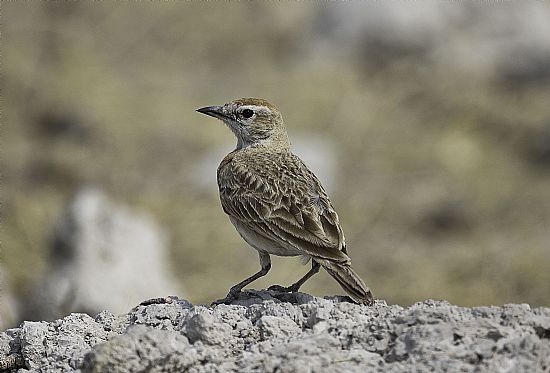
Fawn-coloured Lark
August 1st: Etosha including Halali, Etosha Lookout, Batia, Namutoni
Daily 57 New 8 Running 135
Weather: Sunny with a light N wind 5c-26c
At first light we visited the waterhole to watch dozens of Double-banded Sandgrouse coming into drink. The usual birds were around the campground. After breakfast a walk towards the radio mast was productive for views of Little Swift, Brown-crowned Tchagra, Blue-breasted Cordonbleau and by the reception office Grey-backed Camaroptera. Our first birding stop outside the camp was the track towards Etosha Lookout where we located Red-crested and Northern Black Korhaan, Damara Red-billed and Southern Yellow-billed Hornbills, Double-banded Courser and Lark-like Bunting. Back towards the main track where a stop near the main pan produced sightings of Swallow-tailed Bee-eaters, Southern Pied Babbler, Purple and Lilac-breasted Rollers, Marico Flycatcher, Black-chested Prinia, African Pipit and Red-headed Finches. A detour to Batia provided us with views of Secretarybird strolling around the savanna looking for prey. By the track excellent views of Fawn-coloured Larks singing from the top of small rocks. On the way to Namutoni a kettle of African White-backed, White-headed and Lappet-faced Vultures was a bonus.
Mammals: Brindled Gnu (c), Giraffe (20), Springbok (c), Banded Mongoose (8), Southern Oryx (20), Black-faced Impala (c), South African Ground Squirrel (8), African Elephant (40), Burchell’s Zebra (100), White Rhinoceros (4), Spotted Hyena (1), African Wildcat (1), Yellow Mongoose (2)
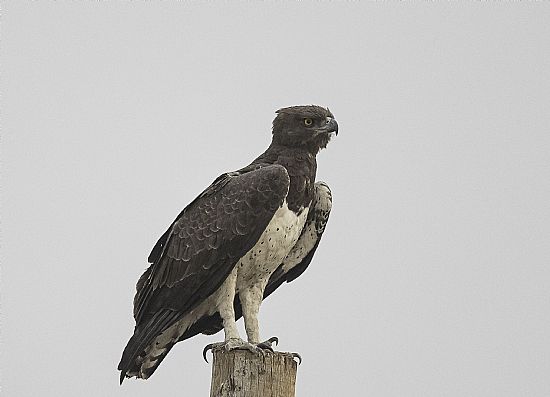
Black-chested Snake Eagle
August 2nd: Namutoni, Waterberg
Daily 51 New 6 Running 141
Weather: Sunny with no winds 24c
After leaving Namutomi we travelled to Waterberg another reserve of woodland, cliffs and farmland. The main road had a Black-chested Snake Eagle perched on a telegraph pole. The common species of rural Namibia were recorded as we travelled south east. A fuel stop with arid fields nearby had a pair of Cape Buntings at close range. Picked up supplies in Otjiwarongo and joined the road to Waterberg. At lunch an African White-backed Vulture flew overhead. The group arrived at Waterberg with sightings of juvenile Common Scimitarbills. A late afternoon walk was productive for Purple Rollers, African Grey Hornbill, Groundscraper Thrush, Brown-crowned Tchagra and Black-backed Puffbacks. The best was three Violet Woodhoopes which displayed and called together in mature trees. A scan of the rocky escarpment revealed a pair of Verreaux’s Eagles perched in trees, Rock Kestrel and Swallow-tailed Bee-eater. On the way to dinner a bonus bird in the form of a Freckled Nightjar hunting insects near our chalets.
Mammals: Warthog (c), Springbok (c), Greater Kudu (1), Banded Mongoose (20), Black-faced Kampala (c), Damara Dik Dik (2), Burchell’s Zebra (20), African Wild Cat (1)
August 3rd: Waterberg
Daily 54 New 8 Running 149
Weather: Hot and sunny with NW winds 6c-30c
Near the restaurant area some of the group located the scarce and localised Ruppell’s Parrot. After breakfast we visited the campground and German Cemetery. On the way down to the campground we encountered a mixed feeding flock comprising of Violet Woodhoopoe, Black-backed Puffback, Brubru, Common Scimitarbill, Acacia Pied Barbet and Lon-billed Crombec. The camp was fairly quiet for birds although sightings of Damara Red-billed Hornbill, Grey-backed Camaroptera, Swallow-tailed Bee-eater and Cape Starling were added. A walk towards the cemetery had sightings of Lesser Masked Weaver, Violet-eared Waxbill, Green-winged Pytilia and Golden-breasted Bunting. At the cemetery itself the group found Rosy-faced Lovebirds, White-browed Scrub Robin and Yellow-bellied Eremomela. Verreaux’s Eagles on the cliffs and Familiar Chats around the chalets plus the commoner birds of Waterberg concluded the mornings birding. 1500 hours with a visit to a cattle farming area east of the reserve. At lunchtime African Paradise Flycatcher and Golden-tailed Woodpecker were added to the list. On the road edge we had sightings of Kalahari and White-browed Scrub Robins and Marico Flycatcher. Further along a Rattling Cisticola gave us close views. Next was the spectacle of a large mixed flock of Shaft-tailed and Long-tailed Paradise Whydahs feeding on the ground and flying up into acacia trees. Beyond the cattle rearing farm Blue-breasted Cordon Bleau in bushes by the road. On the return we had brief views of a pair of Bradfield’s Hornbills in flight plus Marico and Scarlet-chested Sunbirds by the gate.
August 4th: Waterberg, Omaruru
Daily 49 New 2 Running 151
Weather: Sunny with light N winds 28c
Similar birds were seen at Waterberg this morning. After breakfast we headed to Omaruru a cattle town in the Erongo district of Namibia. The only new species was a Chat Flycatcher perched on top of an acacia bush. On arrival at Omaruru checked in at the hotel and arranged a visit to the campground on the edge of town. A walk around produced sightings of Grey-backed Camaroptera, Southern Pied Babbler and a calling Pearl-spotted Owlet which eventually showed high in a tree. In another area a pair of Ruppell’s Parrots showing well near a feeding station. Return to the hotel where up to forty Rosy Lovebirds were observed in the gardens.
Mammals: Chacma Baboon (c), Rock Hyrax (2), Warthog (c), Giraffe (1), Black-faced Impala (c), Burchell’s Zebra (1), Steenbok (1), Black-backed Jackal (1)
August 5th: Omaruru, Erongo
Daily 31 New 4 Running 155
Weather: Cool early morning followed by sunny spells 30c
I left at 0630 to visit the rocky hillside and slopes at Erongo. At dawn we heard the distinctive calls of Hartlaub’s Francolin but we could not locate them visibly. Returned to Omaruru for breakfast and then out again to explore further regions of the Erongo Mountain range. At the first stop we encountered White-tailed Shrikes a stunning bird of Namibia which is almost endemic. Other species present included Chestnut-vented Warbler, Pririt Batis, African Grey, Damara Red-billed, Monteiro’s and Southern Yellow-billed Hornbills. Further along the road Marico Flycatcher, Short-toed Rock Thrush and best of all three Carp’s Tits feeding in green acacia trees. After c35km I turned round and returned to Omaruru to visit the campground where a Ruppell’s Parrot duly obliged by showing well in a tree.
Mammals: Chacma Baboon (c), Klipspringer (1), Warthog (1), Southern Oryx (1), Black-faced Impala (20), Damara Dik Dik (6), Cape Hare (1), Hartmann’s Mountain Zebra (10)
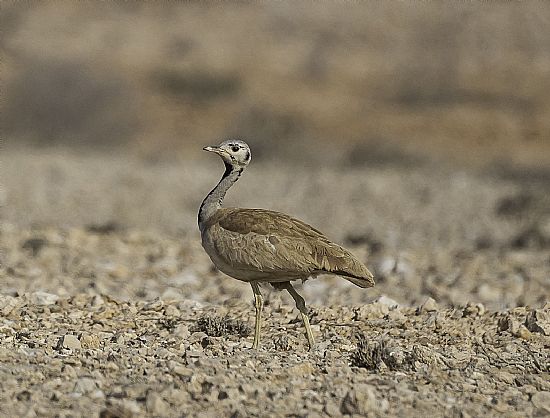
Ruppell's Korhaan
August 6th: Omaruru, Spitzkoppe, Swakopmund
Daily 43 New 7 Running 162
Weather: Sunny with no wind 13c-27c
A return visit to Erongo with similar birds to yesterday morning plus flight views of two Hartlaub’s Francolin and a party of Double-banded Sandgrouse. After breakfast I headed towards the remote settlement of Spitzkoppe and its magnificent rock outcrops. En route we had sightings of Augur Buzzard and the pale form of Tractrac Chat. At Spitzkoppe a visit to the campground with sightings of Rock Kestrel, Mountain Wheatear, Bokmakerie, Short-toed Rock Thrush and Cape Buntings. It was time to head towards Swakopmund on the Atlantic Ocean coast. On leaving Spitzkoppe the village boundary held Pale Chanting Goshawk, Karoo and Familiar Chats and several Double-banded Coursers. Before reaching the B2 road a pair of Ruppell’s Korhaan showed well with a single Gray’s Lark and a Stark’s Lark singing on top of a low acacia bush. The journey to Swakopmund was completed for our three night stop in this most Germanic town in Namibia.
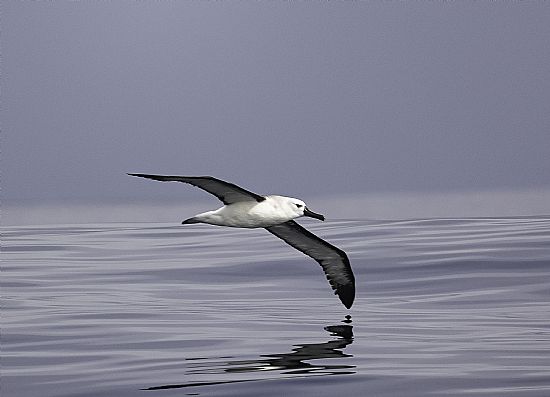
Shy Albatross
August 7th: Swakopmund, Walvis Bay pelagic, Rooibank, Walvis Bay
Daily 41 New 27 Running 189
Weather: Overcast and cool with light NW winds 7c-14c
The majority of today was spent on a pelagic birding tour off Walvis Bay. In the harbour we located Great White Pelican, Hartlaub’s and Kelp Gulls, Cape and Crowned Cormorants. Off Pelican Point we located the first of many Wilson’s Storm Petrels, Sandwich, Common and Damara Terns. At 25km offshore the waters are deeper and cold which attracts many birds of which we observed Shy Albatross, Cape Gannet, Northern Giant Petrel (rare), White-chinned Petrel and Sooty Shearwater. On the return to Walvis Bay harbour a juvenile African Penguin, Grey-hooded Gull and Sanderling. An enjoyable lunch was taken on board and then a visit to the remote village of Rooibank where we hit a problem with soft side which left us being bogged down for an hour. Thankfully a few locals helped us out with towing and digging (a reminder for others at this site for birds). The village had Cape Sparrow, African Red-eyed Bulbul and Rock Martin. Back to Walvis Bay and a look at the lagoons where Greater and Lesser Flamingos were abundant. Other species observed included Cape Teal, Glossy Ibis, Pied Avocet, Black-winged Stilt, Western Cattle Egret, Black-necked Grebe and Wattled Starlings in the grassy areas.
Mammals: Humpback Whale (4), Heaviside’s Dolphin (10), Cape Fur Seal (c)
August 8th: Swakopmund Saltpans, Walvis Bay
Daily 43 New 10 Running 199
Weather: Overcast and cool with a SE wind 5c-15c
The gardens outside the hotel in Swakopmund held Orange River White-eye and Lesser Swamp Warblers plus Cape and House Sparrows. On the roof several Speckled Pigeons were seen by the water tank. A visit to the saltpans north of the city was good for the common waders and a very pale Tractrac Chat catching a scorpion. It was time to head south to Walvis Bay the major port of Namibia and an excellent birding area. On the incoming time the group observed hundreds of Greater and Lesser Flamingos, Kelp, Grey-hooded and Hartlaub’s Gulls and a selection of waders including Chestnut-banded, White-fronted and Grey Plovers. Other species present included Little Stint, White-breasted, Crowned and Cape Cormorants, Black-winged Stilt, Pied Avocet, Ruff, Sanderling and African Black Oystercatcher. A problem with the minibus resulted in a short delay and we ended the day watching birds beyond the saltpans which were similar to the morning with the exception of large numbers of Black-necked Grebes and Greater Crested Terns.
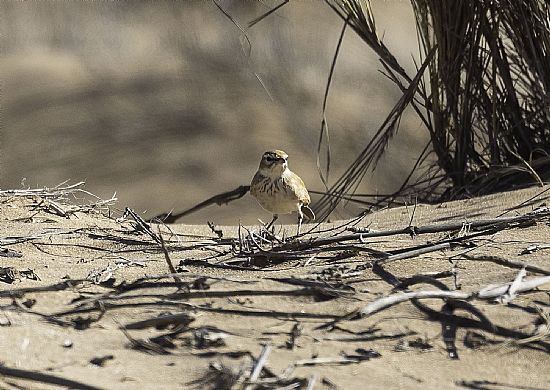
Dune Lark
August 9th: Swakopmund, Rooibank, Windhoek
Daily 48 New 2 Running 201
Weather: Warm and sunny 30c
Mainly a travelling day back to Windhoek and I decided to make a diversion to Rooibank. On arrival the gardens which are a haven for birds in an otherwise harsh environment had Cape and House Sparrows, Lesser Masked Weaver and African Red-eyed Bulbul. A wander through the acacia trees and dunes dotted with grasses eventually produced a pair of the endemic Dune Larks feeding and running around, exceptional views of this sometimes hard to locate bird. Other species present included Southern Fiscal, Red-faced Mousebird, Black-chested Prinia, Chestnut-vented Warbler and a distant Augur Buzzard. The journey to Windhoek was largely uneventful with the common roadside birds observed en route.
August 10th: Arrebusch, Gammas, Avis Dam
Daily 74 New 8 Final 209
Weather: Warm and sunny with NE winds 30c
A pre-breakfast walk around the extensive gardens at Arrebusch added the localised Layard’s Warbler singing from the top of an acacia bush. Other interesting species present included Rosy-faced Lovebirds, Chestnut-vented Warbler, Burnt-necked and Yellow-bellied Eremomela, Acacia Pied Barbet and Cape Starling. The next stop was a return to the water treatment works at Gammas which was once again a productive place for birds. Similar species to our first visit with the addition of Black-headed Heron, Green Sandpipers and at least forty Common Waxbills coming down to drink. The furthest pond was good for high numbers of Egyptian Geese, South African Shelduck, Little Grebe, African Darter and Reed Cormorants. I ended the tour by visiting Avis Dam where bird numbers had decreased slightly from our last visit. The grasses held Black-throated and White-throated Canaries, Blue Waxbill and Rattling Cisticola in a nearby acacia. This same area also had a Pearl-spotted Owlet. A final walk towards the cliffs was good and rewarding as a Rockrunner was seen in a rather secretive and skulking mode. Return to the hotel late afternoon in order to prepare for the journey back to the UK.
Mammals: Yellow Mongoose (6)

